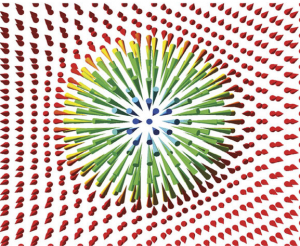 Spintronics, a combination of spin and electronics, not uses only the electrical charge, but also the intrinsic spin of the electron to process information. Recently, non-collinear chiral magnetic structures called skyrmions have received a lot of interest in the field of spintronics. Magnetic skyrmions are particle-like, highly stable vortical objects, in which the magnetization of the atoms rotates from a ferromagnetic background into the opposite direction in the center of the core.
Spintronics, a combination of spin and electronics, not uses only the electrical charge, but also the intrinsic spin of the electron to process information. Recently, non-collinear chiral magnetic structures called skyrmions have received a lot of interest in the field of spintronics. Magnetic skyrmions are particle-like, highly stable vortical objects, in which the magnetization of the atoms rotates from a ferromagnetic background into the opposite direction in the center of the core.
For an application of skyrmions in data storage devices the knowledge of the temperature and magnetic field dependence is crucial. Especially the description of phase transitions is of prime importance. I use an advanced Monte Carlo technique called parallel tempering Monte Carlo (PTMC) to investigate these properties of skyrmion systems.
Skyrmions can be found in so-called frustrated spin systems where different competing interactions occur. This leads to many metastable states in the energy landscape, hence the description of the system needs a highly sophisticated modeling.
The PTMC uses thermal energy to overcome energy barriers between metastable states to sample a large volume of the phase space. Therefore, a certain number of copies of one spin structures, the so called replicas, were created and simulated at different temperatures. During the simulation time, replicas of adjacent temperatures are getting swapped. In doing so, the replicas were heated up and cooled down during the simulation process. This technique allows an accurate thermodynamical study of different magnetic systems which can host magnetic skyrmions.
Research Interest
- Theoretical and computational physics, thermodynamics
- Spintronics, nanomagnetism, spin glass
- Skyrmions and chiral magnetic structures
- Monte Carlo simulations
Publications
- B. Dupé, G. Bihlmayer, M. Böttcher, S. Blügel and S. Heinze, Engineering skyrmions in transition-metal multilayers for spintronics, Nature Communications, 7, p. 11779, 2016.
- M. Böttcher, S. Heinze, S. Egorov and J. Sinova and B. Dupé, B–T phase diagram of Pd/Fe/Ir(111) computed with parallel tempering Monte Carlo, New Journal of Physics, 20, 2018.
- M. Hervé, B. Dupé, R. Lopes, M. Böttcher, M. Martins, T. Balashov, L. Gerhard, J. Sinova and W. Wulfhekel , Stabilizing spin spirals and isolated skyrmions at low magnetic field exploiting vanishing magnetic anisotropy, Nature Communications, 9, 2018.
- I. Lemesh, K. Litzius, M. Böttcher, P. Bassirian, N. Kerber, D. Heinze, J. Zázvorka, F. Büttner, L. Caretta, M. Mann, M. Weigand, S. Finizio, J. Raabe, M. Im, H. Stoll, G. Schütz, B. Dupé, M. Kläui and G. Beach, Current‐Induced Skyrmion Generation through Morphological Thermal Transitions in Chiral Ferromagnetic Heterostructures, Advanced materials, 30, 2018.
- B. Zimmermann, G. Bihlmayer, M Böttcher, M. Bouhassoune, S. Lounis, J. Sinova, S. Heinze, S. Blügel and B. Dupé, Comparison of first-principles methods to extract magnetic parameters in ultrathin films: Co/Pt(111), Physical Review B, 99, 2019.
